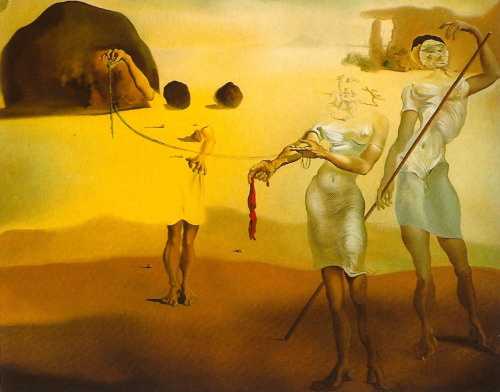Since he was a young boy, Salvador Dali always aimed the push the boundaries, not only in how he created his artwork in terms of style but also how he fabricated his own outward appearance. He made himself into a constantly changing piece of art. As early as in his Self-Portrait (1921), Dali became obsessed with setting himself apart as an eccentric.
"I had let my hair grow as long as a girl's...I was also impatiently waiting for the down on my face to grow, so that I could shave an have long side whiskers. As soon as possible, I wanted to make myself 'look unusual' to compose a masterpiece with my head...These vanities became accentuated after I became aware of the first glances directed toward me, glances by which people wold attract one another's attention to me, and, which said,  'That's the son of Dali the notary.'"
'That's the son of Dali the notary.'"
Another aspect of Dali that is quite distinctive of his style is the fluidity in all his pieces. Easily seen in his Enchanted Beach with Three Fluid Graces (1938), he enjoyed the flow of women's curves and merged them with smooth, desert landscapes.
This is one of the strongest pieces that show Dali's ease with moving between objects and space, distorting perception.
One of his most famous paintings is Daddy Longlegs of the Evening--Hope! (1940), a piece that greatly exaggerates human form almost to the point of losing semblance. The entire weight of the painting as well as the heavy contrast and droopy cello clearly express a sombre sentiment. The figure in the drawing is what Dali considers a "soft self-portrait" that serves the purpose to convey the mood of the painting.
The entire weight of the painting as well as the heavy contrast and droopy cello clearly express a sombre sentiment. The figure in the drawing is what Dali considers a "soft self-portrait" that serves the purpose to convey the mood of the painting.
All his eccentrics and his bizarre nature have pushed Dali to the top of my list of favourite artists. His works are the kind I will stand around and stare at for hours on end, trying to understand how his mind works, how he sees in the world what others don't, and how he puts his thoughts and visions onto a canvas. I do believe that Dali represents the spirit of art itself, manifested in all different forms and always pushing boundaries.
Sources:
 'That's the son of Dali the notary.'"
'That's the son of Dali the notary.'"Another aspect of Dali that is quite distinctive of his style is the fluidity in all his pieces. Easily seen in his Enchanted Beach with Three Fluid Graces (1938), he enjoyed the flow of women's curves and merged them with smooth, desert landscapes.
This is one of the strongest pieces that show Dali's ease with moving between objects and space, distorting perception.
One of his most famous paintings is Daddy Longlegs of the Evening--Hope! (1940), a piece that greatly exaggerates human form almost to the point of losing semblance.
 The entire weight of the painting as well as the heavy contrast and droopy cello clearly express a sombre sentiment. The figure in the drawing is what Dali considers a "soft self-portrait" that serves the purpose to convey the mood of the painting.
The entire weight of the painting as well as the heavy contrast and droopy cello clearly express a sombre sentiment. The figure in the drawing is what Dali considers a "soft self-portrait" that serves the purpose to convey the mood of the painting.All his eccentrics and his bizarre nature have pushed Dali to the top of my list of favourite artists. His works are the kind I will stand around and stare at for hours on end, trying to understand how his mind works, how he sees in the world what others don't, and how he puts his thoughts and visions onto a canvas. I do believe that Dali represents the spirit of art itself, manifested in all different forms and always pushing boundaries.
Sources:
Deon, Michel and Salvador Dali. Diary of a Genius. Trans. Richard Howard. New York: Prentice Hall Press, 1904. Print.
Lubar, Robert S. The Salvador Dali Museum Collection. Boston: Bulfinch Press, 2000. Print.

No comments:
Post a Comment